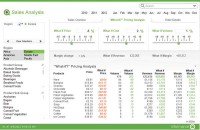 Informance is a QlikView Elite Solution Provider with a real understanding of the food, beverage and grocery industries. It provides the QlikView Business Discovery platform to retailers, wholesalers and distributors who want to gain a deeper insight into the effectiveness of their business and its products and customers. QlikView’s simplicity enables anyone within an organisation to consolidate, search, visualise and analyse their data for unprecedented business insight.
Informance is a QlikView Elite Solution Provider with a real understanding of the food, beverage and grocery industries. It provides the QlikView Business Discovery platform to retailers, wholesalers and distributors who want to gain a deeper insight into the effectiveness of their business and its products and customers. QlikView’s simplicity enables anyone within an organisation to consolidate, search, visualise and analyse their data for unprecedented business insight.
Informance has developed a number of QlikView dashboards that enable businesses within these highly customer-centric industries to make faster, more profitable decisions, using one version of the truth for sales, marketing, merchandising, finance, supply chain and store operations. With QlikView organisations can analyse trends in order to capture consumer loyalty, build and manage their supply chain and reduce the time-to-market to maximise sales, margins and return-on-investment.
Informance provides its customers with a complete business intelligence suite that includes the QlikView Business Discovery platform, personalised dashboard development, implementation, consultancy, training and support. Its impressive customer list includes Aimia Foods, Bakkavör, Del Monte UK, Greencore, Frederic Robinson Brewery, Lakeland Dairies, Musgrave Group, Moy Park, Smithfield Foods and the Tayto Group.
Barry Talbot, Managing Director of Informance Ltd, spoke to The Grocery Trader.
The Grocery Trader – Barry, what does your role as Managing Director involve day to day? Are you personally involved in developing solutions for clients?
In our business, the customer comes first, so I get involved on a daily basis in sales, marketing, and post-sales support tasks. I am not technical, so our delivery team is responsible for turning customers’ data into applications that they can use to increase profitability within their business.
GT – Who else besides you is in the management team?
Besides myself there are two other directors. The three of us started Informance in December 2004 under a different name then rebranded to Informance in 2009 when we changed the company strategy and became an IT solution provider to organisations within several vertical markets.
GT – Where are you based in the UK? How big is Informance now?
![]() We are based in Warwick, which is convenient for the whole of the UK. We are a still a small company with a total of 12 staff, but our goal is to double in size over the next two years.
We are based in Warwick, which is convenient for the whole of the UK. We are a still a small company with a total of 12 staff, but our goal is to double in size over the next two years.
GT – Which countries do you work in besides the UK?
We mainly work in the UK and Ireland, and occasionally in Europe.
GT – If there’s such a thing as a typical Informance business intelligence solution, what does it entail? How much are your solutions tailored to individual clients’ needs?
In terms of what our customers are measuring, we do have a typical business intelligence solution with QlikView. However, each dashboard is tailored to the customer’s individual needs. For example, a project may start with sales analysis and move from there to other functions within a business or it could start in finance or operations.
GT – What is driving the demand for these solutions?
The Business Intelligence market has experienced something of a renaissance with the advent of business – or data – discovery solutions. The QlikView technology is based upon new thinking, as data volumes have exploded and existing business intelligence solutions are hard pressed to remain able to effectively analyse those large volumes.
GT – Fundamental question: what do you mean by the terms business intelligence and business discovery solutions?
Business Intelligence refers to traditional BI tools which historically are complex, rigid, bloated and for selected people. They often fail to deliver what was promised. Business Discovery is user-centric putting the power of data directly into the hands of the business user. It’s simple, nimble, mobile, straightforward, and for everyone.
GT – Which market sectors are you involved with here?
We use our market expertise to focus on legal, manufacturing, retail, wholesale and distribution, although we can deploy a QlikView solution to organisations of any type who require a transparent view of their data, no matter where or how it is stored.
GT – What sets Informance apart from other business intelligence solution vendors?
We deliver real, measurable benefits to our customers including seamless software installations, high levels of consultancy delivered by experienced people who understand the sectors we operate in. We provide our customers with excellent levels of service and support – all delivered by certified trainers for technical staff and end-users – and we have a very happy customer base.
GT – Can you talk us through the different business solutions you offer?
 We are a QlikView only vendor and partner of QlikTech. We have spent time developing our company to achieve the accreditation of QlikView Elite Solution Provider. We have so much belief in the QlikView product that we are totally focused on providing our customers with the QlikView Business Discovery software, supported with full implementation and consultancy services. We back this up with fully certified training services and have successfully installed and currently support many QlikView customers throughout the UK.
We are a QlikView only vendor and partner of QlikTech. We have spent time developing our company to achieve the accreditation of QlikView Elite Solution Provider. We have so much belief in the QlikView product that we are totally focused on providing our customers with the QlikView Business Discovery software, supported with full implementation and consultancy services. We back this up with fully certified training services and have successfully installed and currently support many QlikView customers throughout the UK.
GT – Who are QlikTech?
QlikTech is a USA based company who own the QlikView Business discovery solution. There are a handful of ‘new’ vendors who provide data discovery solutions but QlikTech is the foremost vendor in this space. Business discovery with the QlikView solution enables the analysis of data from anywhere, all within an easy-to-create and use environment.
GT – What does QlikView offer?
QlikView is built around five main themes:
1. Social Business Discovery which is the ability to collaborate on the creation of dashboards, ask and answer questions in formal and informal groups and explore data together to forge new paths and insight to enable effective decision-making.
2. Comparative analysis which extends the QlikView associative experience to enable the comparison of different products or demographics and to analyse consumer purchasing baskets and trends.
3. Mobile business discovery which enables users to access data from any device, with the tablet experience being one of the best ways to view and analyse data.
4. The rapid analytical application platform which helps business users contribute to the creation of analysis quickly and painlessly without requiring lots of involvement from IT.
5. The enterprise platform theme – the QlikView platform contains all the elements you would expect an enterprise platform to contain, including giving the IT department confidence in the security to protect sensitive data and the ability to crunch massive volumes of data.
GT – Is QlikView server-based or cloud-based?
It is mainly server-based, although cloud-based deployments are growing. I’m sure that as cloud-based technology becomes more acceptable, we will see many customers moving their applications to the cloud. We currently have a small percentage of our customers using the cloud, either their own private cloud, or a commercial one.
GT – Have you developed any business intelligence technologies of your own?
No, in the early years we played around with the Microsoft BI stack and when we found QlikView, we became a QlikView-only vendor.
GT – Who are your customers in grocery?
 We have many years’ experience within the food and beverage sectors and customers including: Aimia Foods, Bakkavör, Del Monte UK, Greencore Northampton, Frederic Robinson, Kinnerton Confectionery, Lakeland Dairies, Manor Fresh, Moy Park, Musgrave Retail, Smithfield Foods and the Tayto Group.
We have many years’ experience within the food and beverage sectors and customers including: Aimia Foods, Bakkavör, Del Monte UK, Greencore Northampton, Frederic Robinson, Kinnerton Confectionery, Lakeland Dairies, Manor Fresh, Moy Park, Musgrave Retail, Smithfield Foods and the Tayto Group.
GT – Do you publish customer case studies?
Yes, we do – see opposite page.
GT – How do people use your solutions to access their business data?
QlikView is a powerful solution that has the data extract, the data model (and therefore the data) and the dashboard all in one place. From an analyst user point of view (not the developer point of view), all the user works with is a dashboard that presents their data in the form of graphical or tabular charts and allows them to review trends, drill down into anomalies in the data and make the right decisions based on the relevant information. The social business discovery mentioned earlier allows users to collaborate and discuss trends even when they’re not in the office together. In today’s modern business world, individuals rarely make decisions without first consulting with peers or managers – this is an ideal way to get all the interested parties together at the same time, even if some are out of the office. QlikView is web-based, so a group of people in different places can meet in a web session and discuss the specifics of what the data is telling them, allowing individual users to make selections the rest of the group can see. Another example is a salesman taking his QlikView dashboard with him to see his customer and presenting the dashboard to his customer from any device.
GT – What are they used for day to day?
Every one of our customers has a dashboard that enables them to analyse sales, distribution, financials, purchasing, production and marketing data. These dashboards give them the ability to monitor margins, profitability, performance – in many functional areas – production lines and EPOS data from their customers. Of particular interest to both the manufacturer and the retailer, is the analysis of EPOS data, particularly as they can get store level analysis of product sales and wastage, enabling decision making around increasing sales and reducing wastage, to the financial benefit of both manufacturer and retailer. This analysis is available on a daily, weekly or monthly basis, dependent on how often they want the data refreshed. All these dashboards are deployed with a main theme in mind – to make the company more efficient and thereby saving money or increasing sales, and hence increasing bottom line profits.
GT – How easy are your solutions to operate?
QlikView dashboards covering every functional discipline have been put in place, mostly by the customers I mentioned earlier, without any further input from us. Most new clients require a period of handholding, but once this is done, they seldom have to refer back to us and when they do, it is usually just to check that they are doing the right thing.
GT – How much training do people need?
QlikView requires no training for users, other than those in the business who are responsible for its development – it has been built on the same basis as consumer applications, and like them is simple to use and intuitive enough for the most techno–phobic user.
GT – How are you structured to serve the retail sector? Do you have a dedicated retail team?
 Our sales and delivery teams are set up to deliver solutions into the retail, wholesale, distribution and food and beverage manufacturing sectors. Our sales manager has many years’ experience working in these sectors and from a solutions delivery point of view our consultants all have an in-depth knowledge in the industry and experience of working on many large projects.
Our sales and delivery teams are set up to deliver solutions into the retail, wholesale, distribution and food and beverage manufacturing sectors. Our sales manager has many years’ experience working in these sectors and from a solutions delivery point of view our consultants all have an in-depth knowledge in the industry and experience of working on many large projects.
GT – In our ‘green-obsessed’ times, do your solutions reduce your and the client’s impact on the environment?
Definitely! Our aim is to measure and understand our environmental impact, both collectively and individually and to set achievable goals for reducing, rather than offsetting it. We recognise the environmental process has only just begun, but the foundations have been laid to enable us to demonstrate continuous global improvement in this important area. We are always looking for ways to reduce our environmental impact wherever we operate. The other factor is that our products and the way we deliver them greatly reduce our carbon footprint. For example, QlikView is a single application installed on a single or virtual server, which means businesses do not require a huge bank of hardware. Also, because QlikView is so simple and quick to implement, we do not spend a lot of time travelling to customers and when we do, wherever possible, we use public transport.
GT – What size organisation are your solutions designed for? Can your solutions interface with in-house systems?
QlikView can be used for any size organisation – our customers vary in turnover from £6 million to £1.6 billion! QlikView can extract data from any system – all we require is an ODBC connection to the database. We can import data from multiple system databases into a single dashboard.
GT – How scalable are your solutions as organisations grow?
QlikView is an in-memory application, so as a company and its data grows, it can be as simple as adding additional RAM to the server.
GT – Do you offer a consultancy service for people who are thinking of switching to your solutions?
This is a key area of our offering. We do not approach a prospect with a view to QlikView replacing what they have in place – rather, adding QlikView into their software portfolio to enhance what they already have. If they have invested a fortune in a data warehouse, QlikView will see this as just another data source, so the last thing we would want them to do is write that investment off.
GT – What’s involved in taking on one of your solutions? How long does it take from go ahead to go live?
If an organisation is interested in QlikView, the first step for us is to access their data in order to do a SiB – Seeing is Believing demonstration, which is the name we have given our proof of concept. Given the opportunity, we can produce an example dashboard that will resolve an existing issue which a company has with its reporting in a specific business area, using their data, within five hours. This is followed up with a presentation to the senior management, which can take half an hour to three hours, depending on what they discover in their data. Once the decision has been made, a typical QlikView project starts with the training, followed by the install and consulting. Our customers do not usually need a lot of consultancy, as our objective with any project is to make the customer self-sufficient as quickly as possible. The consulting is normally delivered in about eight weeks, at the end of which, the customer is well on the way to being self-sufficient. So, the answer to the second question is that a customer will be live with the first dashboard in eight weeks – in many cases, much sooner. The total process from the SiB to the customer going live with their first dashboard is around three months.
GT – How long does it take to see a return?
In all cases, we seek to provide a cost and benefits statement before the decision is made to purchase QlikView. We have a wealth of experience in helping customers pinpoint where the savings are to create the return on their investment. We have one customer who had a return on their investment in a week, whilst most show a return within a year.
GT – What effect have the recent and continuing tough economic circumstances had on demand for your solutions?
In the current economic climate the need to know your profitability is even more important than ever. However, we have seen that it takes a bit longer for organisations to make investment decisions because they are concerned about the climate – although the demand for QlikView remains extremely high.
GT – Finally, where do you see Informance going from here?
Based on our growth since 2008, we expect to double in size in the next two years. This is a challenge we are looking forward to as it means we can provide QlikView to more businesses and employment to more people.
Informance Ltd
Tel: 01926 623 456




Comments are closed.